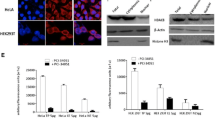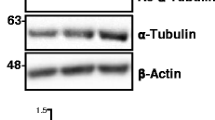Abstract
Human SIRT2 is a cytoplasmic NAD-dependent deacetylase implicated in the mitotic regulation of microtubule dynamics by its association with the class II histone deacetylase 6 (HDAC6). We have previously reported that SIRT2 is multiply phosphorylated in a cell cycle dependent pattern. Here, we demonstrate that HDAC6 binds to both phosphorylated and unphosphorylated forms of SIRT2 and that tubulin binds only to the SIRT2–HDAC6 complex. Tubulin does not bind to either HDAC6 or SIRT2 individually. In addition, we show that replacement of specific serines with alanines in either isoform of SIRT2 regulates its enzymatic activity. We also found that overexpression of isoform2 was deleterious to cell survival. SIRT2 was found to be phosphorylated at serines 368 and 372, outside the conserved core domain of the Sir2 protein family. Double replacement of S368A and S372A reduced SIRT2 deacetylase activity by 44% compared to wildtype activity. Replacements of other serine, threonine, and tyrosine residues, which did not alter the phosphorylation pattern, had varying effects on SIRT2 deacetylase activity but no effect on tubulin/HDAC6 binding.







Similar content being viewed by others
References
Imai S, Armstrong CM, Kaeberlein M, Guarente L (2000) Transcriptional silencing and longevity protein Sir2 is an NAD-dependent histone deacetylase. Nature 403:795–800
Landry J, Sutton A, Tafrov ST, Heller RC et al (2000) The silencing protein SIR2 and its homologs are NAD-dependent protein deacetylases. Proc Natl Acad Sci U S A 97:5807–5811
Aparicio OM, Billington BL, Gottschling DE (1991) Modifiers of position effect are shared between telomeric and silent mating-type loci in S. cerevisiae. Cell 66:1279–1287
Gottlieb S, Esposito RE (1989) A new role for a yeast transcriptional silencer gene, SIR2, in regulation of recombination in ribosomal DNA. Cell 56:771–776
Smith JS, Boeke JD (1997) An unusual form of transcriptional silencing in yeast ribosomal DNA. Genes Dev 11:241–254
Braunstein M, Rose AB, Holmes SG et al (1993) Transcriptional silencing in yeast is associated with reduced nucleosome acetylation. Genes Dev 7:592–604
Kaeberlein M, McVey M, Guarente L (1999) The SIR2/3/4 complex and SIR2 alone promote longevity in Saccharomyces cerevisiae by two different mechanisms. Genes Dev 13:2570–2580
Sinclair DA, Guarente L (1997) Extrachromosomal rDNA circles—a cause of aging in yeast. Cell 91:1033–1042
Tissenbaum HA, Guarente L (2001) Increased dosage of a sir-2 gene extends lifespan in Caenorhabditis elegans. Nature 410:227–230
Lin SJ, Defossez PA, Guarente L (2000) Requirement of NAD and SIR2 for life-span extension by calorie restriction in Saccharomyces cerevisiae. Science 289:2126–2128
Davenport RJ (2004) UnSIRtainty principle. Conflicting results underscore questions about how calorie restriction activates yeast longevity enzyme. Sci Aging Knowledge Environ 2004:nf5
Anderson RM, Latorre-Esteves M, Neves AR et al (2003) Yeast life-span extension by calorie restriction is independent of NAD fluctuation. Science 302:2124–2126
Anderson RM, Bitterman KJ, Wood JG et al (2003) Nicotinamide and PNC1 govern lifespan extension by calorie restriction in Saccharomyces cerevisiae. Nature 423:181–185
Lin SJ, Ford E, Haigis M et al (2004) Calorie restriction extends yeast life span by lowering the level of NADH. Genes Dev 18:12–16
Sauve AA, Moir RD, Schramm VL et al (2005) Chemical activation of Sir2-dependent silencing by relief of nicotinamide inhibition. Mol Cell 17:595–601
Frye RA (1999) Characterization of five human cDNAs with homology to the yeast SIR2 gene: Sir2-like proteins (sirtuins) metabolize NAD and may have protein ADP-ribosyltransferase activity. Biochem Biophys Res Commun 260:273–279
Tanny JC, Dowd GJ, Huang J et al (1999) An enzymatic activity in the yeast Sir2 protein that is essential for gene silencing. Cell 99:735–745
Tanny JC, Moazed D (2001) Coupling of histone deacetylation to NAD breakdown by the yeast silencing protein Sir2: evidence for acetyl transfer from substrate to an NAD breakdown product. Proc Natl Acad Sci U S A 98:415–420
Tanner KG, Landry J, Sternglanz R et al (2000) Silent information regulator 2 family of NAD- dependent histone/protein deacetylases generates a unique product, 1-O-acetyl-ADP-ribose. Proc Natl Acad Sci U S A 97:14178–14182
Sherman JM, Stone EM, Freeman-Cook LL et al (1999) The conserved core of a human SIR2 homologue functions in yeast silencing. Mol Biol Cell 10:3045–3059
Lamming DW, Latorre-Esteves M, Medvedik O et al (2005) HST2 mediates SIR2-independent life-span extension by calorie restriction. Science 310:1124–1125
Frye RA (2000) Phylogenetic classification of prokaryotic and eukaryotic Sir2-like proteins. Biochem Biophys Res Commun 273:793–798
North BJ, Verdin E (2004) Sirtuins: Sir2-related NAD-dependent protein deacetylases. Genome Biol 5:224
Dryden SC, Nahhas FA, Nowak JE (2003) Role for human SIRT2 NAD-dependent deacetylase activity in control of mitotic exit in the cell cycle. Mol Cell Biol 23:3173–3185
Afshar G, Murnane JP (1999) Characterization of a human gene with sequence homology to Saccharomyces cerevisiae SIR2. Gene 234:161–168
Yang YH, Chen YH, Zhang CY et al (2000) Cloning and characterization of two mouse genes with homology to the yeast Sir2 gene. Genomics 69:355–369
Bae NS, Swanson MJ, Vassilev A et al (2004) Human histone deacetylase SIRT2 interacts with the homeobox transcription factor HOXA10. J Biochem (Tokyo) 135:695–700
North BJ, Marshall BL, Borra MT et al (2003) The human Sir2 ortholog, SIRT2, is an NAD+-dependent tubulin deacetylase. Mol Cell 11:437–444
Hiratsuka M, Inoue T, Toda T et al (2003) Proteomics-based identification of differentially expressed genes in human gliomas: down-regulation of SIRT2 gene. Biochem Biophys Res Commun 309:558–566
Gelfand VI, Bershadsky AD (1991) Microtubule dynamics: mechanism, regulation, and function. Annu Rev Cell Biol 7:93–116
Wolf KW, Spanel-Borowski K (1995) Acetylation of alpha-tubilin in different bovine cell types: implications for microtubule dynamics in interphase and mitosis. Cell Biol Int 19:43–52
Westermann S, Weber K (2003) Post-translational modifications regulate microtubule function. Nat Rev Mol Cell Biol 4:938–947
Draberova E, Viklicky V, Draber P (2000) Exposure of lumenal microtubule sites after mild fixation. Eur J Cell Biol 79:982–985
Cambray-Deakin MA, Burgoyne RD (1987) Acetylated and detyrosinated alpha-tubulins are co-localized in stable microtubules in rat meningeal fibroblasts. Cell Motil Cytoskeleton 8:284–291
Webster DR, Borisy GG (1989) Microtubules are acetylated in domains that turn over slowly. J Cell Sci 92(Pt 1):57–65
Smith JS, Tachibana I, Pohl U et al (2000) A transcript map of the chromosome 19q-arm glioma tumor suppressor region. Genomics 64:44–50
Matsuyama A, Shimazu T, Sumida Y et al (2002) In vivo destabilization of dynamic microtubules by HDAC6-mediated deacetylation. Embo J 21:6820–6831
Hubbert C, Guardiola A, Shao R et al (2002) HDAC6 is a microtubule-associated deacetylase. Nature 417:455–458
Satokata I, Benson G, Maas R (1995) Sexually dimorphic sterility phenotypes in Hoxa10-deficient mice. Nature 374:460–463
Moretti P, Freeman K, Coodly L et al (1994) Evidence that a complex of SIR proteins interacts with the silencer and telomere-binding protein RAP1. Genes Dev 8:2257–2269
Seigneurin-Berny D, Verdel A, Curtet S et al (2001) Identification of components of the murine histone deacetylase 6 complex: link between acetylation and ubiquitination signaling pathways. Mol Cell Biol 21: 8035–8044
Hook SS, Orian A, Cowley SM et al (2002) Histone deacetylase 6 binds polyubiquitin through its zinc finger (PAZ domain) and copurifies with deubiquitinating enzymes. Proc Natl Acad Sci U S A 99:13425–13430
Brush MH, Guardiola A, Connor JH et al (2004) Deactylase inhibitors disrupt cellular complexes containing protein phosphatases and deacetylases. J Biol Chem 279:7685–7691
Zhang Y, Li N, Caron C et al (2003) HDAC-6 interacts with and deacetylates tubulin and microtubules in vivo. Embo J 22:1168–1179
Westendorf JJ, Zaidi SK, Cascino JE et al (2002) Runx2 (Cbfa1, AML-3) interacts with histone deacetylase 6 and represses the p21(CIP1/WAF1) promoter. Mol Cell Biol 22:7982–7992
Blander G, Olejnik J, Krzymanska-Olejnik E et al (2005) SIRT1 shows no substrate specificity in vitro. J Biol Chem 280:9780–9785
Juan LJ, Shia WJ, Chen MH et al (2000) Histone deacetylases specifically down-regulate p53-dependent gene activation. J Biol Chem 275:20436–20443
Blom N, Gammeltoft S, Brunak S (1999) Sequence and structure-based prediction of eukaryotic protein phosphorylation sites. J Mol Biol 294:1351–1362
Vaquero A, Scher MB, Lee DH et al (2006) SirT2 is a histone deacetylase with preference for histone H4 Lys 16 during mitosis. Genes Dev 20:1256–1261
Finnin MS, Donigian JR, Pavletich NP (2001) Structure of the histone deacetylase SIRT2. Nat Struct Biol 8:621–625
Avalos JL, Boeke JD, Wolberger C (2004) Structural basis for the mechanism and regulation of Sir2 enzymes. Mol Cell 13:639–648
Avalos JL, Bever KM, Wolberger C (2005) Mechanism of sirtuin inhibition by nicotinamide: altering the NAD(+) cosubstrate specificity of a Sir2 enzyme. Mol Cell 17:855–868
Cho HP, Liu Y, Gomez M et al (2005) The dual-specificity phosphatase CDC14B bundles and stabilizes microtubules. Mol Cell Biol 25: 4541–4551
Acknowledgements
We would like to thank Anton-Scott Goustin for assistance in the design of some of the primers for the mutagenesis of SIRT2 as well as for many helpful discussions and Megan Stojcevski for her computer graphic skills. This work was supported by the Barbara and Fred Erb Endowed Chair in Cancer Genetics to M.A.T.; funds from the Karmanos Cancer Institute (P30CA022453); specifically the Applied Genomics Core and Biostatistics Core of the Karmanos Cancer Institute.
Author information
Authors and Affiliations
Corresponding author
Rights and permissions
About this article
Cite this article
Nahhas, F., Dryden, S.C., Abrams, J. et al. Mutations in SIRT2 deacetylase which regulate enzymatic activity but not its interaction with HDAC6 and tubulin. Mol Cell Biochem 303, 221–230 (2007). https://doi.org/10.1007/s11010-007-9478-6
Received:
Accepted:
Published:
Issue Date:
DOI: https://doi.org/10.1007/s11010-007-9478-6




